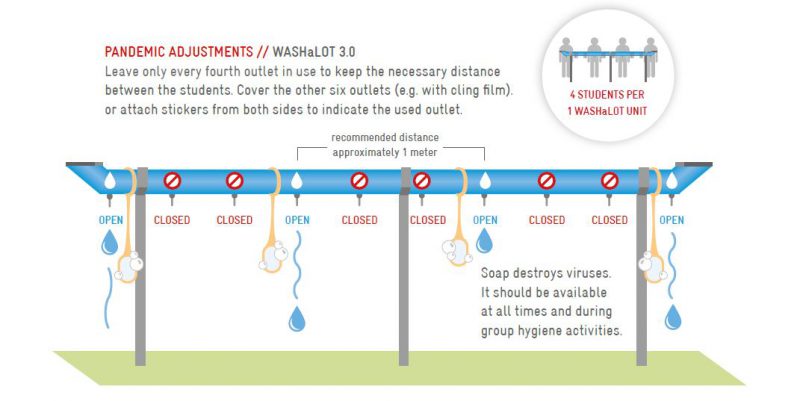The COVID-19 pandemic has caused disruption to education systems around the world and has forced schools in many countries to temporarily shut down to control the spread of the disease. A number of these schools are now beginning to reopen or are set to resume activities in the coming weeks.
There is currently still no vaccination against COVID-19 nor a widespread herd immunity, and experts have warned that a second wave of infections is possible, thus highlighting the need for everyone to adopt risk-minimizing behaviour. Particular attention has to be paid on WASH in schools and on personal hygiene.

Handwashing with Soap is important!
Schools should establish the rule that students have to practice handwashing with soap prior to entering the school and regularly throughout the day as one of the most effective measures against COVID-19 infection and transmission. Soap contains molecules that can destroy the outer coating of the virus: almost any soap is comprised of two-sided molecules, with one side being attracted to water and the other side to fat, which, when interacting with the virus, breaks apart the outer coating of proteins and fats that surround the virus. However, it takes at least 20 seconds to effectively eliminate the virus, meaning that hands have to be washed for at least 20 seconds. The Fit for School manuals (e.g. the FIT Lao manual on pages 18 and 19, which can be accessed HERE) provide clear guidance on how to organize handwashing activities in schools and how to engage students through having them go through the handwashing steps or washing their hands to a song. Ideally teachers also remind the students to wash their hands with soap when they arrive back at home.
While implementing physical distancing measures may demand more time and planning, conducting handwashing in groups with appropriate physical distancing being observed remains the only feasible way to include the activity as part of the school day without disrupting the rest of the day.
Group Handwashing Facilities are necessary for schools
Currently handwashing facilities are being designed with only one or two water outlets to maximize distance in order to adhere to physical distancing rules. However, assuming that at one point in the future we can all stand closer together again, it is important to remember for any school (and any Ministry of Education) that daily handwashing should be part of the school routine and this can only realistically be achieved by organizing group activities and having the necessary group facilities. It is therefore important to promote the continued use and construction of group handwashing facilities, but adapt them temporarily for the time being, e.g. close or cover water outlets.

How to use group facilities during physical distancing
In the above graphic of the group handwashing facility WASHaLOT 3.0 and the photo from Indonesia you will find concrete suggestions how to adapt existing group handwashing facilities, so that when practicing physical distancing, only every second or third outlet is used to keep students at an appropriate distance from one another. For older WASHaLOT versions a stopgap measure is to cover a number of the punch-holes with duct tape (or even paint) to keep students at an appropriate distance. Aside from adjustments on the facility itself, it is also important that management aspect of washing hands should also be adjusted to follow physical distancing protocols.
Do not forget to be consistent with physical distancing measures as part of the school day: physical distancing should also be observed in classrooms, school cafeterias and on the schoolgrounds in order to be effective!
To assist schools without handwashing facilities, Fit for School has worked on various catalogues, including:
- a global compendium in collaboration with UNICEF (link HERE);
- a catalogue of different models at different price points in Lao PDR (link HERE);
- and in Cambodia (link HERE).


